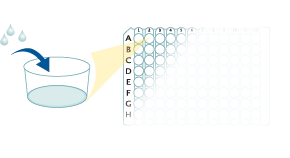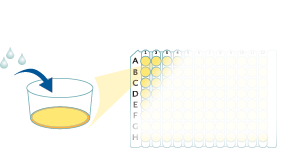Mouse CCL20/MIP-3 alpha Quantikine ELISA Kit Summary
Product Summary
Precision
Cell Culture Supernates, Serum, Heparin Plasma
| Intra-Assay Precision | Inter-Assay Precision | |||||
|---|---|---|---|---|---|---|
| Sample | 1 | 2 | 3 | 1 | 2 | 3 |
| n | 20 | 20 | 20 | 23 | 23 | 23 |
| Mean (pg/mL) | 10 | 43 | 118 | 11 | 40 | 112 |
| Standard Deviation | 0.6 | 1.7 | 5.9 | 1 | 3.6 | 7.5 |
| CV% | 6 | 4 | 5 | 9.1 | 9 | 6.7 |
Recovery
The recovery of mouse MIP-3 alpha spiked to three levels throughout the range of the assay in various matrices was evaluated.
| Sample Type | Average % Recovery | Range % |
|---|---|---|
| Cell Culture Supernates (n=4) | 100 | 96-106 |
| Heparin Plasma (n=4) | 98 | 85-115 |
| Serum (n=4) | 106 | 95-119 |
Linearity
Scientific Data
Preparation and Storage
Background: CCL20/MIP-3 alpha
CCL20, also known as MIP-3 alpha, is a chemokine that plays an important role in dendritic cell trafficking and recruitment and activation of T cells. It is upregulated in monocytes, T cells, endothelial cells, epithelial cells, and fibroblasts following inflammatory stimulation. CCL20 signals through CCR6 which is expressed on memory T cells, B cells and bone marrow-derived dendritic cells.
Assay Procedure
Refer to the product- Prepare all reagents, standard dilutions, and samples as directed in the product insert.
- Remove excess microplate strips from the plate frame, return them to the foil pouch containing the desiccant pack, and reseal.
- Add 50 µL of Assay Diluent to each well.
- Add 50 µL of Standard, Control, or sample to each well. Cover with a plate sealer, and incubate at room temperature for 2 hours on a horizontal orbital microplate shaker.
- Aspirate each well and wash, repeating the process 4 times for a total of 5 washes.
- Add 100 µL of Conjugate to each well. Cover with a new plate sealer, and incubate at room temperature for 2 hours on the shaker.
- Aspirate and wash 5 times.
- Add 100 µL Substrate Solution to each well. Incubate at room temperature for 30 minutes on the benchtop. PROTECT FROM LIGHT.
- Add 100 µL of Stop Solution to each well. Read at 450 nm within 30 minutes. Set wavelength correction to 540 nm or 570 nm.





Citations for Mouse CCL20/MIP-3 alpha Quantikine ELISA Kit
R&D Systems personnel manually curate a database that contains references using R&D Systems products. The data collected includes not only links to publications in PubMed, but also provides information about sample types, species, and experimental conditions.
18
Citations: Showing 1 - 10
Filter your results:
Filter by:
-
Intestinal Flora Changes Induced by a High-Fat Diet Promote Activation of Primordial Follicles through Macrophage Infiltration and Inflammatory Factor Secretion in Mouse Ovaries
Authors: Z Fan, X Zhang, Y Shang, M Zou, M Zhou, Q E, S Fei, W Chen, J Li, X Zhang, X Liu
International Journal of Molecular Sciences, 2022-04-27;23(9):.
Species: Mouse
Sample Types: Cell Culture Supernates
-
IL-36 signalling enhances a pro-tumorigenic phenotype in colon cancer cells with cancer cell growth restricted by administration of the IL-36R antagonist
Authors: K Baker, C O'Donnell, M Bendix, S Keogh, J Byrne, M O'Riordain, P Neary, A Houston, E Brint
Oncogene, 2022-04-01;0(0):.
Species: Mouse
Sample Types: Cell Culture Supernates
-
CCL20-CCR6 axis modulated traumatic brain injury-induced visual pathologies
Authors: M Das, X Tang, JY Han, K Mayilsamy, E Foran, MR Biswal, R Tzekov, SS Mohapatra, S Mohapatra
J Neuroinflammation, 2019-05-31;16(1):115.
Species: Mouse
Sample Types: Tissue Homogenates
-
Tumor suppressor microRNA-204-5p regulates growth, metastasis, and immune microenvironment remodeling in breast cancer
Authors: BS Hong, HS Ryu, N Kim, J Kim, E Lee, H Moon, KH Kim, MS Jin, NH Kwon, S Kim, D Kim, DH Chung, K Jeong, K Kim, KY Kim, HB Lee, W Han, J Yun, JI Kim, DY Noh, HG Moon
Cancer Res., 2019-02-08;0(0):.
Species: Mouse
Sample Types: Cell Culture Supernates
-
Obesity exacerbates colitis-associated cancer via IL-6-regulated macrophage polarisation and CCL-20/CCR-6-mediated lymphocyte recruitment
Authors: CM Wunderlich, PJ Ackermann, AL Ostermann, P Adams-Quac, MC Vogt, ML Tran, A Nikolajev, A Waisman, C Garbers, S Theurich, J Mauer, N Hövelmeyer, FT Wunderlich
Nat Commun, 2018-04-25;9(1):1646.
Species: Mouse
Sample Types: Cell Culture Supernates
-
Lung Epithelial Cells Coordinate Innate Lymphocytes and Immunity against Pulmonary Fungal Infection
Authors: N Hernández-, DL Wiesner, JS Fites, AJ McDermott, T Warner, M Wüthrich, BS Klein
Cell Host Microbe, 2018-03-22;0(0):.
Species: Mouse
Sample Types: BALF
-
Prion infection of mouse brain reveals multiple new upregulated genes involved in neuroinflammation or signal transduction.
Authors: Carroll J, Striebel J, Race B, Phillips K, Chesebro B
J Virol, 2014-12-10;89(4):2388-404.
Species: Mouse
Sample Types: Tissue Homogenates
-
Leukocyte attraction by CCL20 and its receptor CCR6 in humans and mice with pneumococcal meningitis.
Authors: Klein M, Brouwer M, Angele B, Geldhoff M, Marquez G, Varona R, Hacker G, Schmetzer H, Hacker H, Hammerschmidt S, van der Ende A, Pfister H, van de Beek D, Koedel U
PLoS ONE, 2014-04-03;9(4):e93057.
Species: Mouse
Sample Types: Tissue Homogenates
-
Potential roles of CCR5(+) CCR6(+) dendritic cells induced by nasal ovalbumin plus Flt3 ligand expressing adenovirus for mucosal IgA responses.
Authors: Fukuyama Y, Tokuhara D, Sekine S, Aso K, Kataoka K, Davydova J, Yamamoto M, Gilbert R, Tokuhara Y, Fujihashi K, Kunisawa J, Yuki Y, Kiyono H, McGhee J, Fujihashi K
PLoS ONE, 2013-04-02;8(4):e60453.
Species: Mouse
Sample Types: Cell Culture Supernates
-
Monocyte-derived dendritic cell recruitment and allergic T(H)2 responses after exposure to diesel particles are CCR2 dependent.
Authors: Provoost S, Maes T, Joos GF, Tournoy KG
J. Allergy Clin. Immunol., 2011-09-08;129(2):483-91.
Species: Mouse
Sample Types: BALF
-
CCL20, gammadelta T cells, and IL-22 in corneal epithelial healing.
Authors: Li Z, Burns AR, Miller SB, Smith CW
FASEB J., 2011-04-25;25(8):2659-68.
Species: Mouse
Sample Types: Tissue Homogenates
-
The Role of ChemR23 in the Induction and Resolution of Cigarette Smoke-Induced Inflammation.
Authors: Demoor T, Bracke KR, Dupont LL
J. Immunol., 2011-03-23;186(9):5457-67.
Species: Mouse
Sample Types: BALF
-
NOD1 contributes to mouse host defense against Helicobacter pylori via induction of type I IFN and activation of the ISGF3 signaling pathway.
Authors: Watanabe T, Asano N, Fichtner-Feigl S, Gorelick PL, Tsuji Y, Matsumoto Y, Chiba T, Fuss IJ, Kitani A, Strober W
J. Clin. Invest., 2010-04-12;120(5):1645-62.
Species: Mouse
Sample Types: Tissue Homogenates
-
Th17 Cytokines Stimulate CCL20 Expression in Keratinocytes In Vitro and In Vivo: Implications for Psoriasis Pathogenesis.
Authors: Harper EG, Guo C, Rizzo H, Lillis JV, Kurtz SE, Skorcheva I, Purdy D, Fitch E, Iordanov M, Blauvelt A
J. Invest. Dermatol., 2009-03-19;129(0):2175.
Species: Mouse
Sample Types: Tissue Homogenates
-
Tyrosine phosphatase SHP-1 in oxidative stress and development of allergic airway inflammation.
Authors: Cho YS, Oh SY, Zhu Z
Am. J. Respir. Cell Mol. Biol., 2008-04-25;39(4):412-9.
Species: Mouse
Sample Types: BALF
-
Mouse models of rhinovirus-induced disease and exacerbation of allergic airway inflammation.
Authors: Bartlett NW, Walton RP, Edwards MR, Aniscenko J, Caramori G, Zhu J, Glanville N, Choy KJ, Jourdan P, Burnet J, Tuthill TJ, Pedrick MS, Hurle MJ, Plumpton C, Sharp NA, Bussell JN, Swallow DM, Schwarze J, Guy B, Almond JW, Jeffery PK, Lloyd CM, Papi A, Killington RA, Rowlands DJ, Blair ED, Clarke NJ, Johnston SL
Nat. Med., 2008-02-03;14(2):199-204.
Species: Mouse
Sample Types: BALF
-
Chemokine receptor CCR2 but not CCR5 or CCR6 mediates the increase in pulmonary dendritic cells during allergic airway inflammation.
Authors: Robays LJ, Maes T, Lebecque S, Lira SA, Kuziel WA, Brusselle GG, Joos GF, Vermaelen KV
J. Immunol., 2007-04-15;178(8):5305-11.
Species: Mouse
Sample Types: BALF
-
An inflammation-induced mechanism for leukocyte transmigration across lymphatic vessel endothelium.
Authors: Johnson LA, Clasper S, Holt AP, Lalor PF, Baban D, Jackson DG
J. Exp. Med., 2006-11-20;203(12):2763-77.
Species: Mouse
Sample Types: Cell Culture Supernates
FAQs
No product specific FAQs exist for this product, however you may
View all ELISA FAQsReviews for Mouse CCL20/MIP-3 alpha Quantikine ELISA Kit
There are currently no reviews for this product. Be the first to review Mouse CCL20/MIP-3 alpha Quantikine ELISA Kit and earn rewards!
Have you used Mouse CCL20/MIP-3 alpha Quantikine ELISA Kit?
Submit a review and receive an Amazon gift card.
$25/€18/£15/$25CAN/¥75 Yuan/¥2500 Yen for a review with an image
$10/€7/£6/$10 CAD/¥70 Yuan/¥1110 Yen for a review without an image





